Previous issue | Next issue | Archive
![]() Volume 13 (1); January 25, 2023 [Booklet] [EndNote XML for Agris]
Volume 13 (1); January 25, 2023 [Booklet] [EndNote XML for Agris]
Research Paper
Effects of clove (Syzygium aromaticum) on productive performance, nutrients value and digestibility, blood lipid profile, antioxidant status and immune response of growing rabbits
Suliman MAE, Ahmed FG, El-Kholy KhF, Mohamed RAE and Abdel-Mawla LF.
Online J. Anim. Feed Res., 13(1): 01-09, 2023; pii: S222877012300001-13
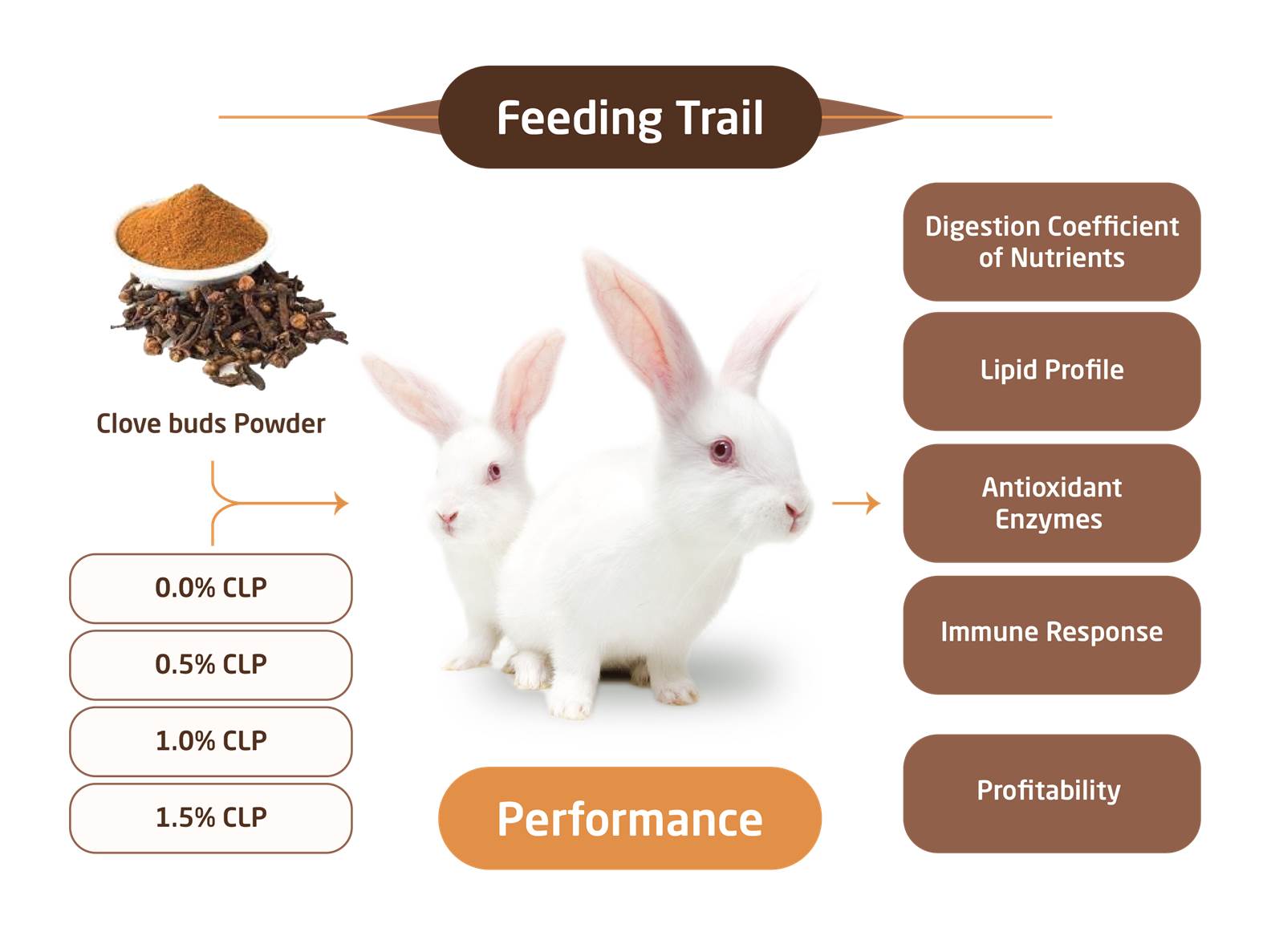 DOI: https://dx.doi.org/10.51227/ojafr.2023.1
DOI: https://dx.doi.org/10.51227/ojafr.2023.1
|
|
Abstract
The current study evaluated the effect of feeding clove (Syzygium aromaticum) as a natural additive on productive performance, digestibility and nutritive value, antioxidant enzymes activities, and immune response of growing rabbits. A total of 48 New Zealand White (NZW) rabbits aged 6 weeks were randomly allocated to 4 groups (12 rabbits/group). Clove buds powder (CLP) was supplemented at 0.5, 1, and 1.5% of basal diet. Four tested diets formulated to contain basal diet without CLP (treatment 1, T1), 0.5% CLP (T2), 1% CLP (T3), and 1.5% CLP (T4). The animals were provided pelleted diets and fresh water ad libitum throughout the experimental period. The rabbits fed diets containing CLP improved FCR (P=0.007) and consumed (P<0.0001) less than those fed control group. The diet containing 1.5% CLP had the best feed conversion ratio (FCR) value (P<0.05). No significant differences were observed among experimental groups in all nutrients digestibility except CP digestibility significantly (P=0.0261) increased with 0.5 and 1% CLP groups compared to control group. Blood total lipid (TL) was significantly decreased (P<0.009) with increasing the dietary level of CLP, (being 379.17 and 361.11 mg/dl for 1% and 1.5% CLP groups vs. 470.84 for control group). The catalase and total antioxidant capacity (TAOC) concentrations significantly (P<0.0001) increased with CLP groups compared to control group. The immunoglobulins titres (IgG and IgM) improved (P>0.05) with rabbits fed CLP diets when compared to those fed the control diet. In conclusion, using CLP as an alternative feed additive in rabbit’s diets up to 1.5% without any adverse effect on productive performance and vital activities. The CLP inclusion in rabbit diets decreased feed intake (FI), improved FCR and increased profitability, moreover, had a positive effect on antioxidant enzyme activity and immunity (IgG and IgM) titres.
Keywords: Antioxidant status, Clove, Immune, Performance, Rabbits
[Full text-PDF] [Scopus] [ePub] [Export from ePrint]
Research Paper
Effects of biosecurity practices on the health management system of poultry farms in Nigeria
Aderemi FA, Ayandiji A, and Adeleke GO.
Online J. Anim. Feed Res., 13(1): 10-15, 2023; pii: S222877012300002-13
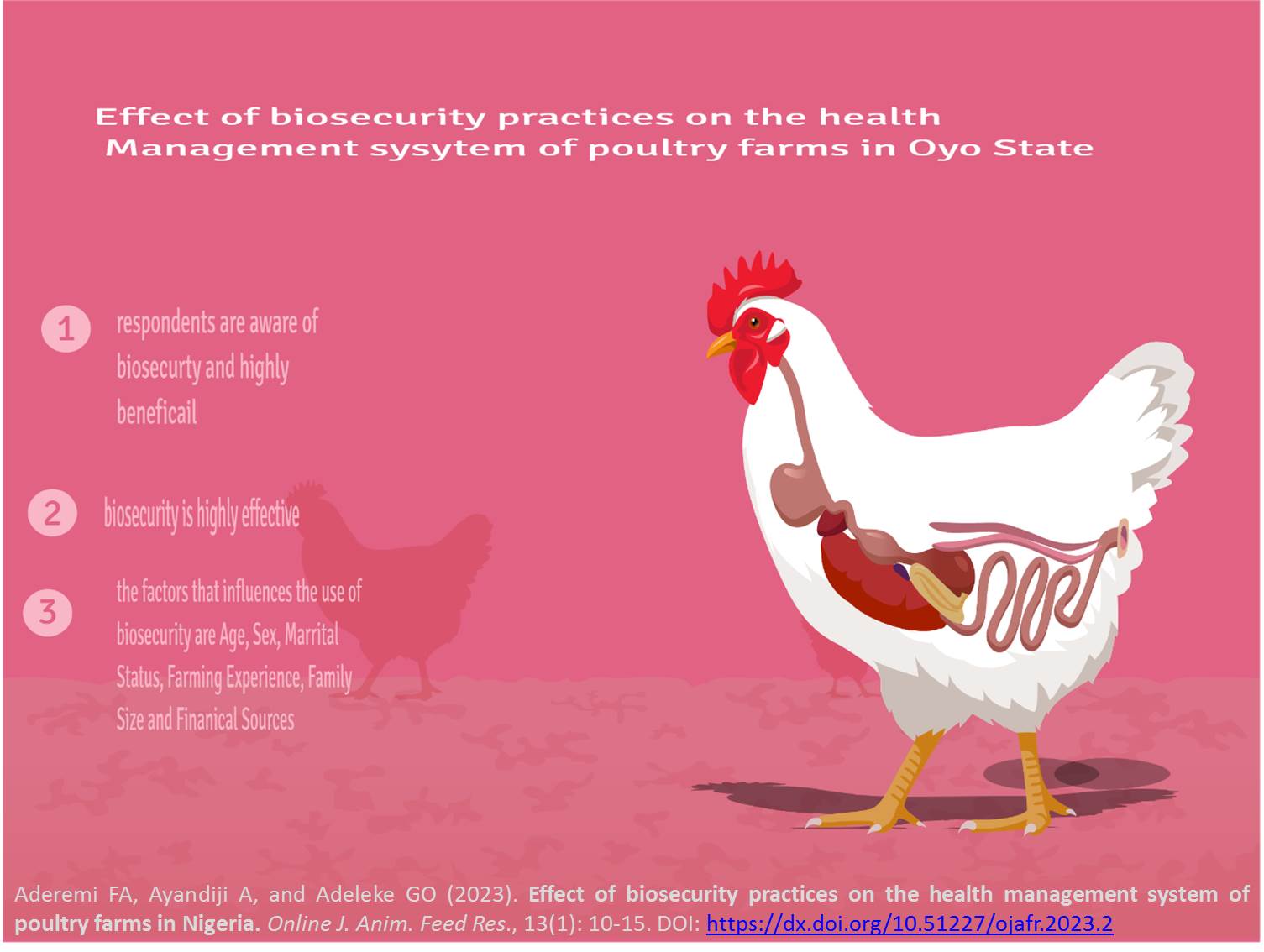 DOI: https://dx.doi.org/10.51227/ojafr.2023.2
DOI: https://dx.doi.org/10.51227/ojafr.2023.2
|
|
Abstract
The purpose of the study was to determine how Oyo State, Nigerian biosecurity strategies, affected the poultry health management system. The regional data were collected through a planned investigation. The 120 respondents were selected using random and purposeful sampling approaches. The analysis revealed that 43.3% of poultry farmers were between the ages of 31 and 40; the majority were men; 72.5% were married; 37.5% had been in farming for between 11 and 20 years, and 95.5% had one to six children. Most farmers (75.8%) reported that raising poultry was their main source of income; 70.8% stated they got their information from the farmers' association; 95.0% stated burning birds reduced susceptibility to infectious diseases, and nearly all (99.2%) stated keeping foot dips in place stopped the spread of infectious diseases. According to the regression analysis, there is a strong correlation between respondents' age, sex, marital status, agricultural experience, family size, source of income, and adoption of biosecurity methods in the research region. The greatest and most affordable way of infection protection can be found in biosecurity. Without appropriate biosecurity measures, no single disease prevention program will succeed. It is can be concluded that the introduction of additional biosecurity measures could be a significant boost to the prevention and spread of poultry diseases in the study area.
Keywords: Biosecurity strategies, Commercial Farm, Health Management Practices, Infection protection, Poultry.
[Full text-PDF] [Scopus] [ePub] [Export from ePrint]
Research Paper
Effects of graded levels of dietary chromium-yeast on rumen and blood metabolites, feed digestibility, and performance of goats
Suryapratama W, Munasik, Susanti E, Widiyastuti T, Yuwono P, Prayitno CH.
Online J. Anim. Feed Res., 13(1): 16-22, 2023; pii: S222877012300003-13
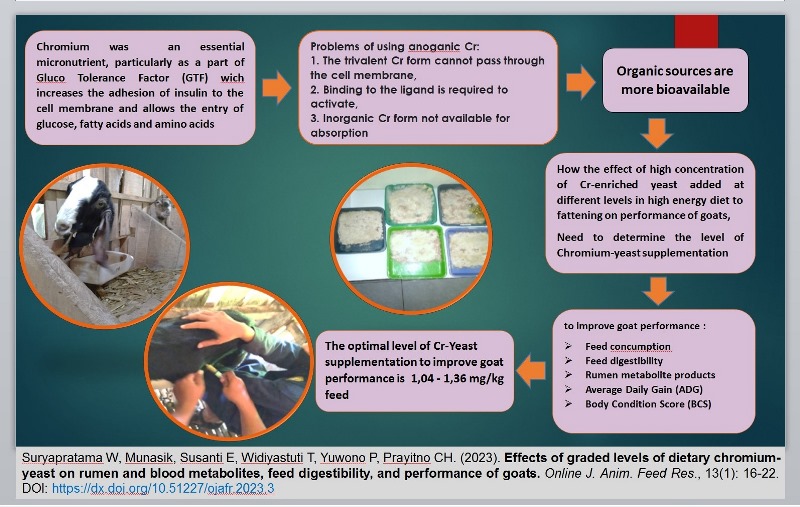 DOI: https://dx.doi.org/10.51227/ojafr.2023.3
DOI: https://dx.doi.org/10.51227/ojafr.2023.3
Abstract
|
|
The study was conducted to determine the effect of dietary supplementation of Chromium-yeast minerals on consumption, feed digestibility, rumen and blood metabolites, Average Daily Gain (ADG) and body condition score (BCS). The research was conducted at Gunung Tugel Farm, Banyumas, Central Java, Indonesia. The material used was 24 male Jawarandu goats with an average initial weight of 25 ± 1.23 kg, individual cages, the feed given consisted of elephant grass silage and concentrate. The treatment feed contains chromium-yeast at levels of 0, 0.5, 1, and 1.5 mg/kg. The research method used was experimental using a completely randomized design. There were 4 treatments tested, namely T0 (70% concentrate + 30% elephant grass silage), T1 (70% concentrate + 30% elephant grass silage + 0.5 mg/kg chromium-yeast), T2 (70% concentrate + 30% elephant grass silage + 1 mg/kg chromium-yeast) and T3 (70% concentrate + 30% elephant grass silage + 1.5 mg/kg chromium-yeast). Each treatment was repeated 6 times so there were 24 trials. The further test used is polynomial orthogonal. The variables measured in this study were feed consumption, feed digestibility, rumen metabolite products, daily body weight gain and body condition score. The results of the analysis of variance showed that the treatment had a significant effect on dry matter and organic matter consumption, feed digestibility, rumen volatile fatty acids (VFA), ammonia nitrogen (NH3-N) and blood glucose 3 h post-feeding, chromium-yeast levels, and had a very significant effect on ADG and BCS. In conclusion, chromium-yeast supplementation was able to improve goat performance with optimal levels ranging from 1.04–1.36 mg/kg of feed.
Keywords: Body condition score, Chromium-yeast, Daily gain, Goat
[Full text-PDF] [Scopus] [ePub] [Export from ePrint]
Research Paper
Control of dipterids in a feedlot under construction in a forest area of center region of Cameroon
Sevidzem SL, Burinyuy KA, Mintsa Nguema R, Mavoungou JF.
Online J. Anim. Feed Res., 13(1): 23-29, 2023; pii: S222877012300004-13
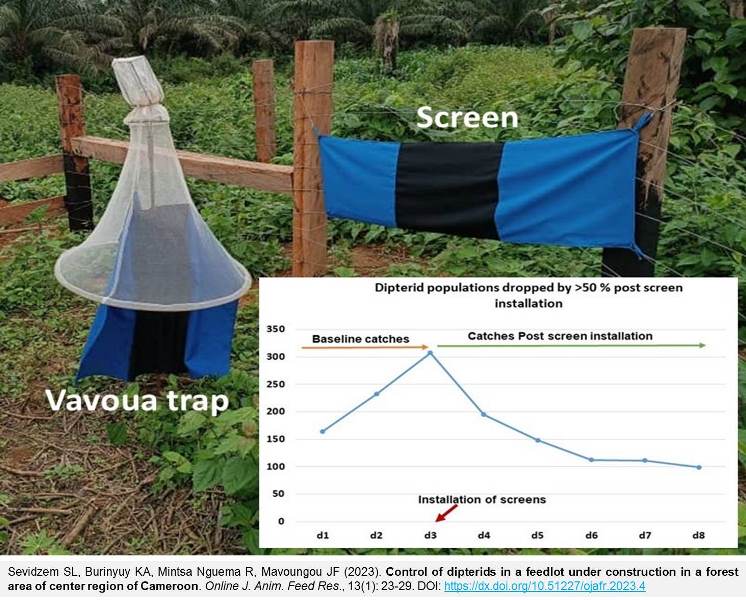 DOI: https://dx.doi.org/10.51227/ojafr.2023.4
DOI: https://dx.doi.org/10.51227/ojafr.2023.4
|
|
Abstract
The forest agro-ecological zone of Cameroon is heavily infested with biting dipterids, but no control is ongoing in this part of the country. In the rainy season (May 2022) in a feedlot under construction in Ndogbea village, eight days entomological study consisting of (i) baseline fly collection using five vavoua traps set in all the sides of a one hectare feedlot yard for four days and (ii) installation of deltamethrin impregnated screens set at 1m from trap and their spraying at frequency of two days in four days. About 1368 biting and non-biting dipterids were collected and classified under five important genera namely Musca, Stomoxys, Tabanus, Chrysops, and Glossina. Musca spp. were frequent than other species. Only one Glossina fuscipes fuscipes was identified. The vavoua trap (VT4) facing the forest with canopy trees had highest fly catches. The apparent density (ADT) of all the fly genera dropped from pre-screen installation phase (ADT=86.8flies/trap/day (f/t/d)) to screen installation phase (ADT= 38.2 f/t/d) with overall fly population density reduction rate of 55.99%. However, there was no statistically significant difference (Χ²=35.000; df =30; P=0.243) in population density reduction rates of the various fly-groups. In conclusion, five dipterid groups of veterinary and zoonotic importance constituted the fly-vector fauna of Ndogbea village. The presence of deltamethrin impregnated screens contributed to the fly population density reduction rate of 55.99%. An integrated approach including: animal spraying, herd hygiene, use of traps and screens is needed to maintain low fly numbers in this feedlot.
Keywords: Dipterids, Feedlot, Fly-vector, Forest, Parasite.
[Full text-PDF] [Scopus] [ePub] [Export from ePrint]
Case Report
Symptomatic reponible umbilical hernia in the rabbit
Lutvikadić I, Spahija N, and Maksimović A.
Online J. Anim. Feed Res., 13(1): 30-33, 2023; pii: S222877012300005-13
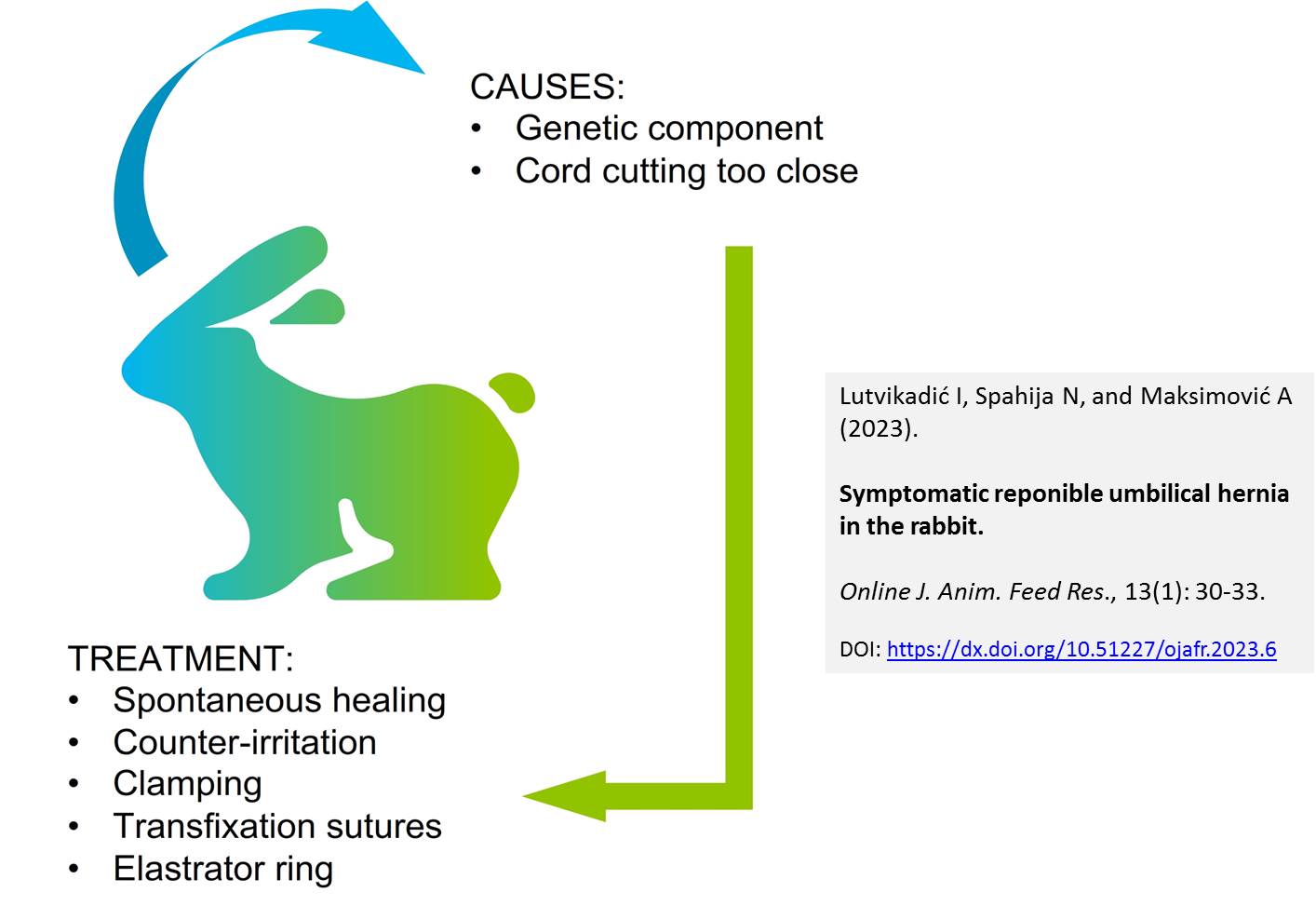 DOI: https://dx.doi.org/10.51227/ojafr.2023.5
DOI: https://dx.doi.org/10.51227/ojafr.2023.5
|
|
Abstract
A case of umbilical hernia in a 7-month-old female rabbit was presented to the Surgery Clinic of the Veterinary Faculty, University of Sarajevo. The owner noticed inappetence and lethargy four days before arrival at the clinic. Clinical parameters on physical examination were within the physiological range. Bruxism and lethargy were noted as signs of discomfort due to gas accumulation in colon. A reponible, nonpainful mass in the umbilical scar area was palpated but intestinal peristalsis was not altered. General anesthesia was induced by intramuscular administration of ketamine with medetomidine and maintained with isoflurane. Surgical treatment of hernia included the peritoneal sac dissection and amputation, repositioning of small intestines, and correction of abdominal wall defect. Intraoperative multimodal analgesia approach was used to reduce inhalant anesthesia requirements and to prevent pain-related and stress-related complications. In this case report we described a surgical and veterinary treatment of the reponible umbilical hernia in a rabbit.
Keywords: Herniorrhaphy, Rabbit, Umbilical hernia, Veterinary treatment
[Full text-PDF] [Scopus] [ePub] [Export from ePrint]
Review
Avian cellulitis: a skin affection associated with economic losses in broiler chickens
Abd El-Ghany WA.
Online J. Anim. Feed Res., 13(1): 34-38, 2023; pii: S222877012300006-13
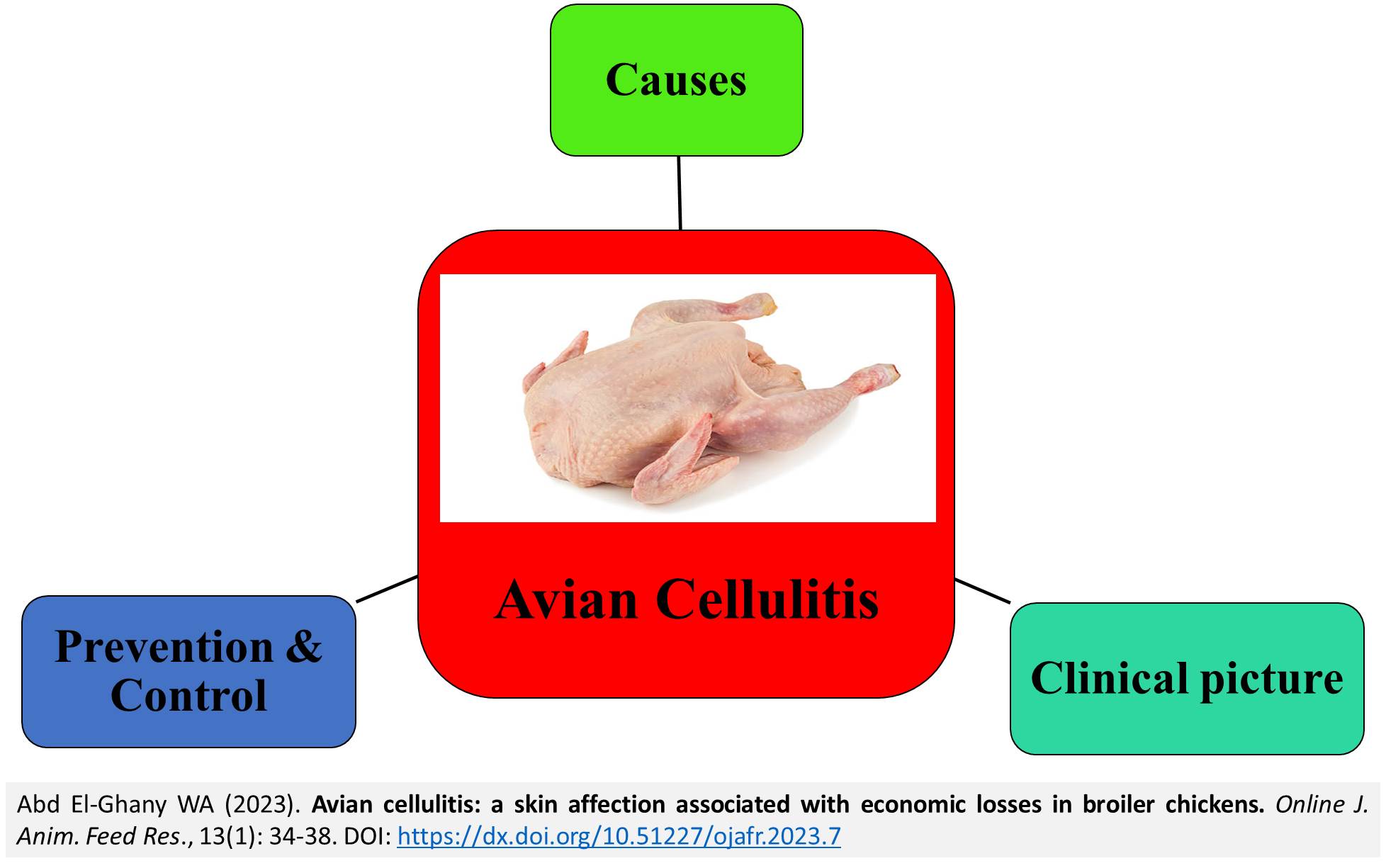 DOI: https://dx.doi.org/10.51227/ojafr.2023.6
DOI: https://dx.doi.org/10.51227/ojafr.2023.6
|
|
Abstract
This review was designed for focusing on cellulitis condition in broiler chickens regarding causes, clinical picture, and prevention measures of this condition. Cellulitis is an acute diffuse inflammation of subcutaneous tissues and muscles especially on the skin of thighs and abdomen. This condition is more common in broilers than others and it is usually associated with economic losses. At processing, low grade chicken carcasses and high incidences of condemnation are the sequels of cellulitis. Skin integrity, stocking density, and litter conditions are predisposing factors for induction of cellulitis. However, other infectious bacterial and immunosuppressive viral pathogens are associated with cellulitis. Affected birds display areas of yellow skin along with a plaque of pus underneath the skin and the underlying muscles show hemorrhages. Presence of caseous, yellowish to green, dark red, or brown fetid gangrenous exudate could also be observed in the advanced cellulitis cases. Prevention and control of cellulitis are based on application of hygienic practices, vaccination, antibiotic therapy, genetic selection, and nutrition.
Keywords: Avian cellulitis, Broiler, Disorder, Lesions, Skin.
[Full text-PDF] [Scopus] [ePub] [Export from ePrint]
Research Paper
Fermentation of blood meal absorbed by oil palm fronds with Bacillus amyloliquefaciens and Lactobacillus plantarum
Imsya A, Riswandi, Malik B, Yakup.
Online J. Anim. Feed Res., 13(1): 39-45, 2023; pii: S222877012300007-13
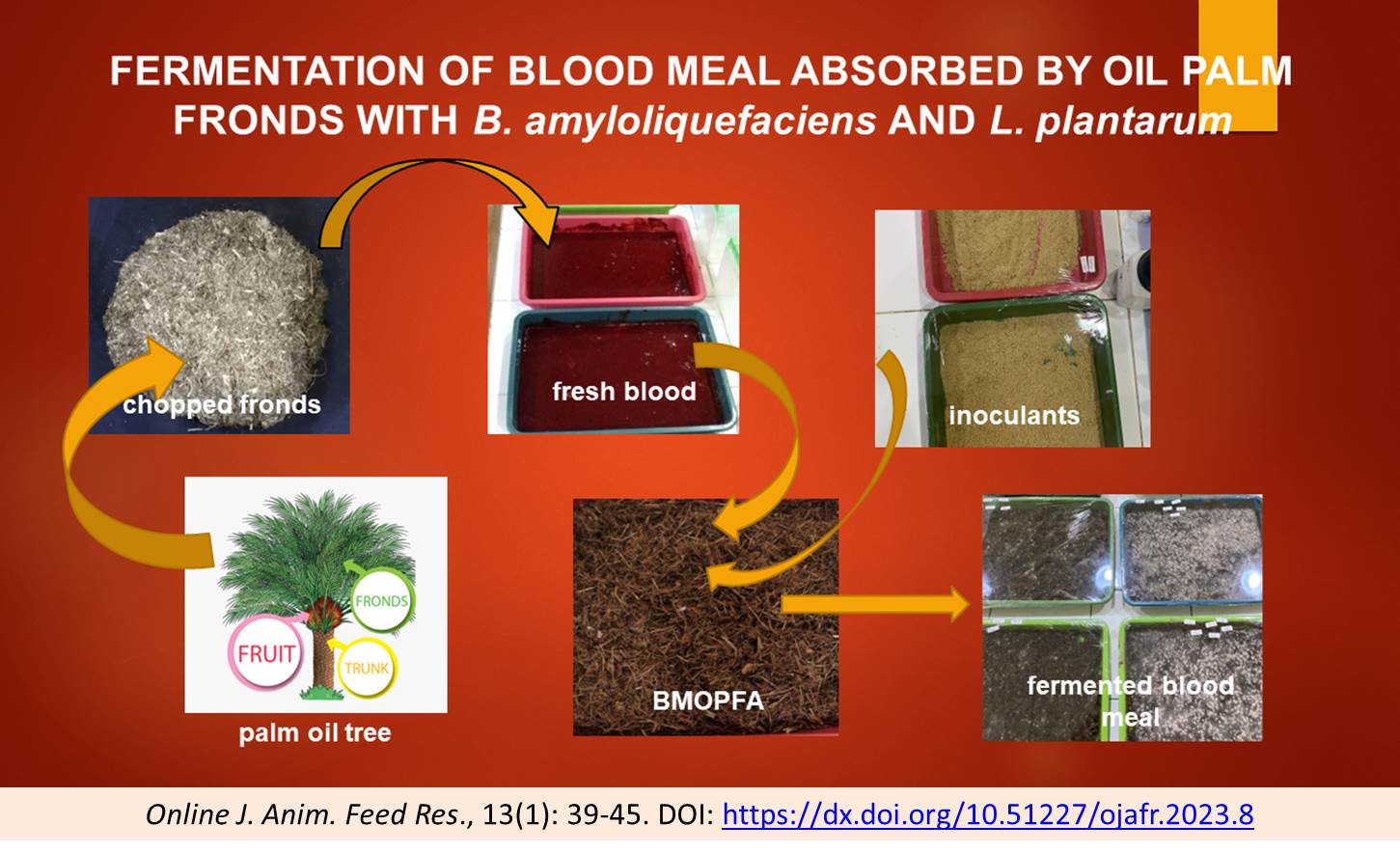 DOI: https://dx.doi.org/10.51227/ojafr.2023.7
DOI: https://dx.doi.org/10.51227/ojafr.2023.7
|
|
Abstract
This study was aimed at improving the efficiency of blood meal (BM) use as feedstuff through the application of agricultural waste absorbance and fermentation technology. Blood was absorbed by oil palm fronds and fermented by using Bacillus amyloliquefaciens (BAF) and Lactobacillus plantarum (BLP) inoculants in 0, 60, and 120 hour incubation times. Quality was assessed by using Van Soest fiber analysis and in vitro digestibility trial on the best fermented product. Results showed that there was significant interaction effect (P<0.05) of inoculant type and fermentation times on the changes in fiber fraction of BM absorbed by oil palm fronds. Inoculant types were found to give significant effects (P<0.05) on ration digestibility rate and in vitro rumen condition characteristics. It was concluded that fermentation of BM absorbed with palm oil fronds with BLP in 120 hours resulted in BM with the best fiber fraction reduction, digestibility rate, and in vitro rumen condition characteristics.
Keywords: Agricultural waste, Feedstuff, Fiber fraction, Digestibility, Rumen condition.
[Full text-PDF] [Scopus] [ePub] [Export from ePrint]
Research Paper
Effects of different processing methods on nutrient contents and acceptability of hog plum (Spondias mombin Linn.) leaf by West African Dwarf sheep
Ikusika OO, Mako AA, and Mpendulo Th.
Online J. Anim. Feed Res., 13(1): 46-54, 2023; pii: S222877012300008-13
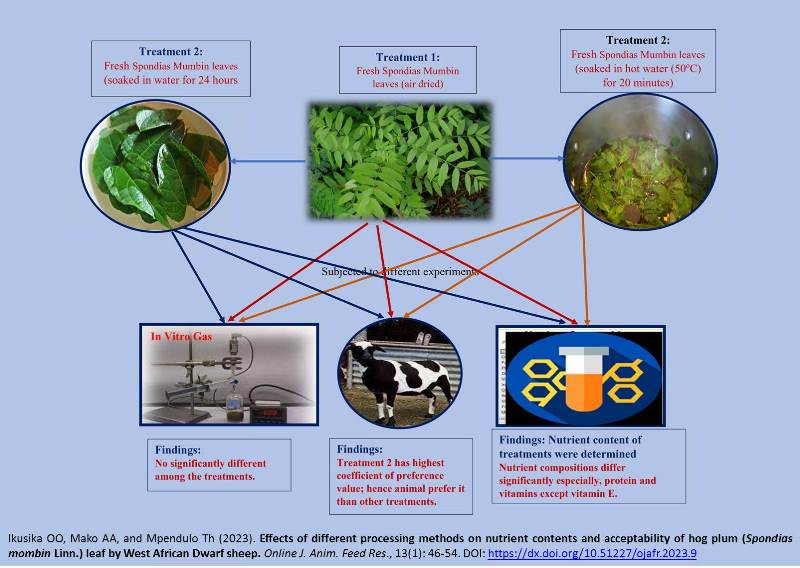 DOI: https://dx.doi.org/10.51227/ojafr.2023.8
DOI: https://dx.doi.org/10.51227/ojafr.2023.8
|
|
Abstract
Three experiments were conducted to evaluate the effect of processing method on leaves from Spondias mombin tree as fodder for ruminants in the tropics. The leaves were subjected to three different physical processing methods; T1 control (fresh but air drying), T2 (fresh but soaked in ordinary water for 24 h then air drying), and T3 (fresh but soaked in water at 50oC for 20 min then air drying). Nutrient and secondary metabolites content were determined in experiment 1. In experiment II, the Coefficient of preference (CoP) was determined. In vitro gas production was used to predict metabolizable energy (ME), organic matter digestibility (OMD), short-chain fatty acid (SCFA) and methane (CH4) of S. mombin leave with different processing methods in experiment 111. Results revealed significant differences in the chemical composition of S. mombin leaf subjected to different processing methods. The dry matter value was highest in S. mombin leaves soaked in hot water (90.22%), and lowest in S. mombin leaves soaked in water at room temperature (85.05%). Crude protein was highest in leaf processed with hot water (11.25 %) and lowest in control (9.59 %). No significant variations were observed for minerals and anti-nutrients investigated. The Vitamin content of leaves of S. mombin tree with various processing methods differed significantly except for vitamin E. The preference coefficient value was greater in leaves soaked at 50oC for 20 mins than leaves from the other processing method and control. All leaves of S. mombin tree from all processing methods considered in this study were acceptable to the animals, but leaves soaked in 50oC for 20 mins were most preferred. The in vitro gas production parameters and characteristics were not significantly different. In conclusion, S. mombin leaf subjected to 50 oC for 20 mins is more advantageous as forage in animal nutrition than unprocessed.
Keywords: In vitro gas production, Nutritional value, Processing method; Ruminant, Spondias mombin leaf.
[Full text-PDF] [Scopus] [ePub] [Export from ePrint]
Research Paper
Effect of different levels of fermented water hyacinth leaf meal on feed utilization and performance of juvenile Nile tilapia
Emshaw Y, Getahun A and Geremew A.
Online J. Anim. Feed Res., 13(1): 55-62, 2023; pii: S222877012300009-13
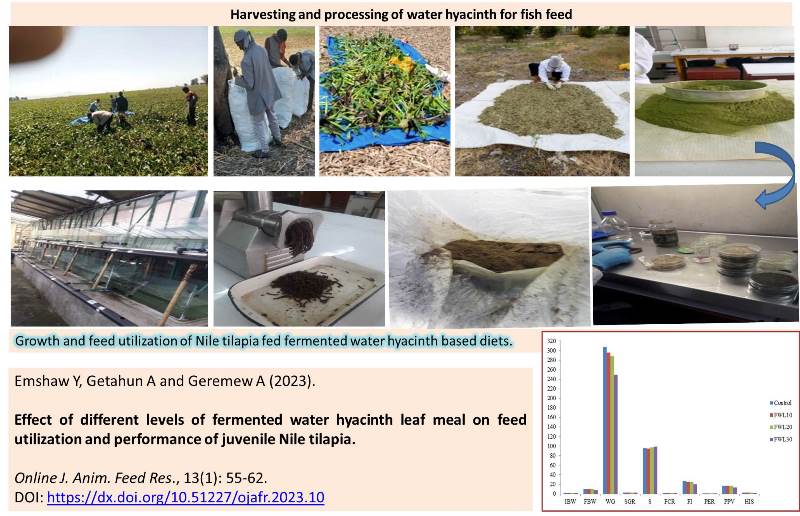 DOI: https://dx.doi.org/10.51227/ojafr.2023.9
DOI: https://dx.doi.org/10.51227/ojafr.2023.9
|
|
Abstract
This study was conducted to evaluate the effects of different inclusion levels of water hyacinth leaf meal fermented with Aspergillus niger on feed utilization efficiency and growth performance of Nile tilapia (Oreochromis Niloticus L.). Fermented water hyacinth leaf (FWHL) at 0, 10, 20 and 30% inclusion levels were incorporated into four isonitrogenous (35% CP), and isoenergetic (18 KJ g-1 g) test diets. The fishes were stocked in 80 liters aquarium units, in a closed, recirculating indoor system. The diets were fed to triplicate groups of fish fingerlings (1.6 g average body weight) twice a day, at 6% of body weight/day, for three months. The study demonstrated that Nile tilapia fed FWHL at levels 30% had a significant negative impact (P<0.05) on weight gain, specific growth rate, feed utilization efficiency, and whole body composition. But, there were no significant changes between diets supplemented with 10% and 20% FWHL when compared with the control group. Therefore, supplementation of fermented water hyacinth leaf meal to diets of Nile tilapia is recommended up to 20% because it is cheaper than fish meal and corn.
Keywords: Body composition, Feed utilization, Growth performance, Nile tilapia, Water hyacinth
[Full text-PDF] [Scopus] [ePub] [Export from ePrint]
Systematic Review
A systematic review on the development of quail ovary embryogenesis (Coturnix coturnix Japonica) under different lighting colors
Mafruchati M, Makuwira J and Wardhana AK.
Online J. Anim. Feed Res., 13(1): 63-68, 2023; pii: S222877012300010-13
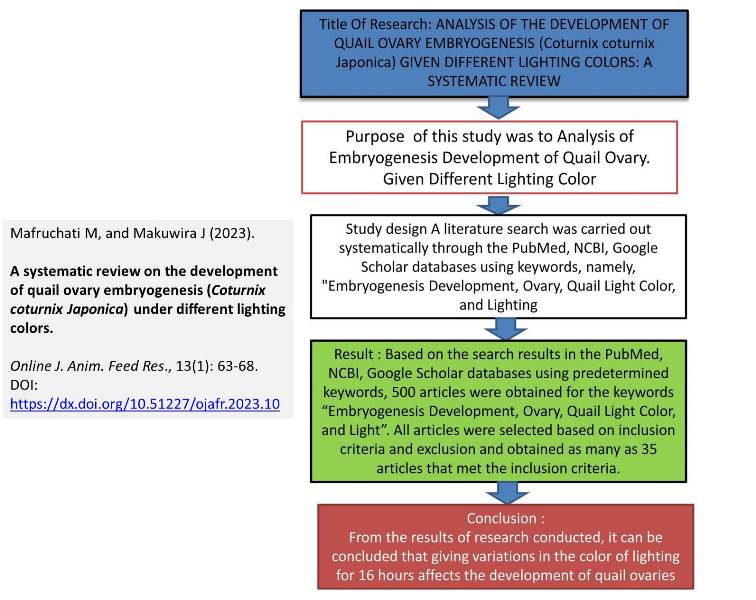 DOI: https://dx.doi.org/10.51227/ojafr.2023.10
DOI: https://dx.doi.org/10.51227/ojafr.2023.10
|
|
Abstract
Quail (Coturnix coturnix Japonica) is one of the commercial poultry that is being developed and produced more frequently. Various lighting programs (pre-hatching) on Aves have been carried out to provide an increased biological response, including growth, reproduction, and productivity. The addition of light or the lighting program is also a factor in the growth of Aves which directly plays a role in controlling various physiological processes. The purpose of this study was to review embryogenesis development of the Quail ovary under various lighting conditions. A literature search was carried out systematically through the PubMed, NCBI, and Google Scholar databases using keywords, namely, "embryogenesis development, ovary, quail light color, and lighting”. The articles obtained were selected based on these keywords by setting several inclusion criteria. Papers that do not meet the inclusion criteria are eliminated, and articles that meet the criteria will be analyzed to obtain data. Based on the search results in the databases using predetermined keywords, 500 articles were obtained. All articles were selected based on inclusion criteria and exclusion and obtained as many as 35 articles that met the inclusion criteria. From the results of the research, it can be concluded that giving variations in the colour of lighting for 16 hours affects the development of quail ovaries. Because of the significant effect of lighting and its colour on embryo development, pre-hatch lighting programs should be considered in future studies.
Keywords: Egg, Embryogenesis, Incubation, Lighting, Quail.
[Full text-PDF] [Scopus] [ePub] [Export from ePrint]
Research Paper
Detection of genetically modified soybean seed, soybean meal and rice in Karbala city of Iraq
Al-khafaji KM, Alrashedi AAM, Al-Mosawy WF, Muhammed HA.
Online J. Anim. Feed Res., 13(1): 69-72, 2023; pii: S222877012300011-13
 DOI: https://dx.doi.org/10.51227/ojafr.2023.11
DOI: https://dx.doi.org/10.51227/ojafr.2023.11
|
|
Abstract
Rice and soybean are two high-demanded grains for human foods and animal feeds. The current study aimed as first time in one of Iraqi region to find genetically modified soybean seed, soybean meal and rice grain samples utilizing the Cauliflower mosaic virus (CaMV) 35S promoter and nopaline synthase (NOS) terminator catalyst like Agrobacterium tumefaciens NOS (ANOS) terminator, in PCR tests. A total of 55 samples of soybeans seed, soybean meal, and rice cereal were collected from the market in Karbala, Iraq. The samples were collected from markets in Karbala city during January-March 2021, and evaluated in the Food Laboratory, College of Al Safwa University of Karbala, Iraq. DNA was isolated from dry vegetable samples. Two genes, including CaMV-35S and NOS terminator, that are routinely used in genetic engineering were employed to evaluate genetically modified crops. The present study revealed CaMV-35S and NOS genes in soybean meals. In conclusion, the obtained results indicated that all rice samples tested with the same primers were genetically unaltered. Whereas, there is genetically alternations in soybean seeds and soybean meal.
Keywords: Genetically modified seeds, Feedstuff, Soybean meal, Rice, CaMV-35S, NOS terminator.
[Full text-PDF] [Scopus] [ePub] [Export from ePrint]
Research Paper
Effect of graded levels of guava (Psidium guajava L.) leaf meal on productive performance and meat organoleptic properties of chicken
Abang FBP, Echeonwu IE, and Amu MU.
Online J. Anim. Feed Res., 13(1): 73-78, 2023; pii: S222877012300012-13
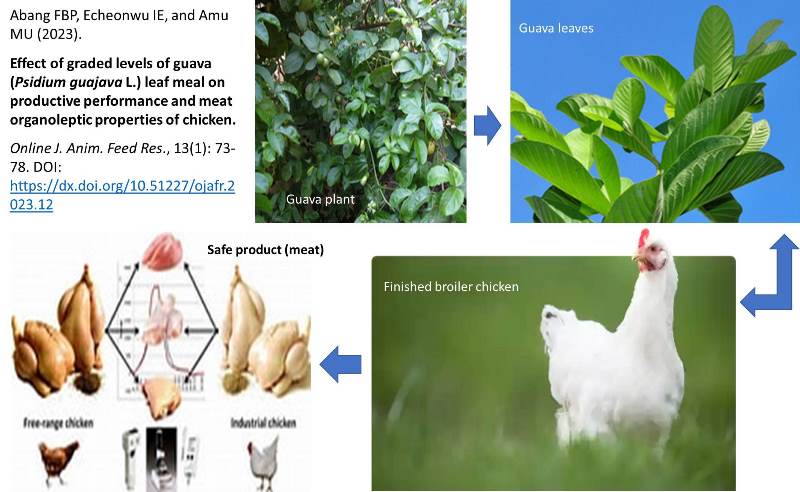 DOI: https://dx.doi.org/10.51227/ojafr.2023.12
DOI: https://dx.doi.org/10.51227/ojafr.2023.12
|
|
Abstract
A study was carried out to determine the productive performance and meat organoleptic properties of finisher broiler fed diets supplemented with graded levels of dried guava leaf meal (DGLM) as a phytogenic feed additive. The study was conducted at the livestock experimental unit of National Veterinary Research Institute Vom, Nigeria. Two hundred and forty unsexed 5-weeks-old broilers of similar mean live weight were randomly assigned to 1 of 4 dietary groups with 3 replicates (0, 150g, 300g and 450g of DGLM per 100kg basal diets) over a four weeks finisher period, in completely randomized design. All the diets of iso-nitrogenous and iso-caloric and water were served to the birds ad libitum. The results of the finisher phase of the experiment showed that, though the average daily feed intakes of all the treatments were the same, the final body weights of birds fed T4 diets were significantly (P<0.05) higher than those fed other diets. Feed conversion ratio (FCR), protein efficiency ratio (PER) and feed cost/weight gain followed similar trend as in body weight gain. The organoleptic properties (colour, appearance, texture, taste and aroma) of all the treatment groups revealed that DGLM had no adverse effect on broiler meat. The study concluded that the supplementation of DGLM at 300g and 450g/ 100kg enhanced utilization of nutrients in the diets resulting in impressive growth performance, reduced feed cost/weight gain, and high survivability without influencing the organoleptic properties of finisher broiler chickens.
Keywords: Broiler Chickens, Guava Leaf Meal, Herbal additive, Productive Performance, Organoleptic Properties.
[Full text-PDF] [Scopus] [ePub] [Export from ePrint]
Previous issue | Next issue | Archive
This work is licensed under a Creative Commons Attribution 4.0 International License (CC BY 4.0).![]()
| < Prev | Next > |
|---|


